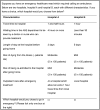Preferences for centralised emergency medical services: discrete choice experiment
- PMID: 31694847
- PMCID: PMC6858184
- DOI: 10.1136/bmjopen-2019-030966
Preferences for centralised emergency medical services: discrete choice experiment
Abstract
Objectives: It is desirable that public preferences are established and incorporated in emergency healthcare reforms. The aim of this study was to investigate preferences for local versus centralised provision of all emergency medical services (EMS) and explore what individuals think are important considerations for EMS delivery.
Design: A discrete choice experiment was conducted. The attributes used in the choice scenarios were: travel time to the hospital, waiting time to be seen, length of stay in the hospital, risks of dying, readmission and opportunity for outpatient care after emergency treatment at a local hospital.
Setting: North East England.
Participants: Participants were a randomly sampled general population, aged 16 years or above recruited from Healthwatch Northumberland network database of lay members and from clinical contact with Northumbria Healthcare National Health Service Foundation Trust via Patient Experience Team.
Primary and secondary outcome measures: Analysis used logistic regression modelling techniques to determine the preference of each attribute. Marginal rates of substitution between attributes were estimated to understand the trade-offs individuals were willing to make.
Results: Responses were obtained from 148 people (62 completed a web and 86 a postal version). Respondents preferred shorter travel time to hospital, shorter waiting time, fewer number of days in hospital, low risk of death, low risk of readmission and outpatient follow-up care in their local hospital. However, individuals were willing to trade off increased travel time and waiting time for high-quality centralised care. Individuals were willing to travel 9 min more for a 1-day reduction in length of stay in the hospital, 38 min for a 1% reduction in risk of death and 112 min for having outpatient follow-up care at their local hospital.
Conclusions: People value centralised EMS if it provides higher quality care and are willing to travel further and wait longer.
Keywords: centralisation; discrete choice experiment; emergency medical services; preferences.
© Author(s) (or their employer(s)) 2019. Re-use permitted under CC BY-NC. No commercial re-use. See rights and permissions. Published by BMJ.
Conflict of interest statement
Competing interests: None declared.
Figures
Similar articles
-
The Australian public's preferences for emergency care alternatives and the influence of the presenting context: a discrete choice experiment.BMJ Open. 2015 Apr 3;5(4):e006820. doi: 10.1136/bmjopen-2014-006820. BMJ Open. 2015. PMID: 25841233 Free PMC article.
-
Preferences of patients for emergency services available during usual GP surgery hours: a discrete choice experiment.Fam Pract. 2005 Feb;22(1):28-36. doi: 10.1093/fampra/cmh623. Epub 2004 Nov 4. Fam Pract. 2005. PMID: 15528284
-
Preferences heterogeneity of health care utilization of community residents in China: a stated preference discrete choice experiment.BMC Health Serv Res. 2020 May 18;20(1):430. doi: 10.1186/s12913-020-05134-4. BMC Health Serv Res. 2020. PMID: 32423447 Free PMC article.
-
Exploring Relative Preferences for HIV Service Features Using Discrete Choice Experiments: a Synthetic Review.Curr HIV/AIDS Rep. 2020 Oct;17(5):467-477. doi: 10.1007/s11904-020-00520-3. Curr HIV/AIDS Rep. 2020. PMID: 32860150 Free PMC article. Review.
-
Understanding depression treatment and perinatal service preferences of Kenyan pregnant adolescents: A discrete choice experiment.PLoS One. 2023 Mar 8;18(3):e0273274. doi: 10.1371/journal.pone.0273274. eCollection 2023. PLoS One. 2023. PMID: 36888596 Free PMC article. Review.
Cited by
-
Parental preferences for pediatric surgical facility centralization: insights from a discrete choice experiment.Pediatr Surg Int. 2025 Aug 24;41(1):266. doi: 10.1007/s00383-025-06165-w. Pediatr Surg Int. 2025. PMID: 40849860
-
Distance travelled to hospital for emergency laparotomy and the effect of travel time on mortality: cohort study.BMJ Qual Saf. 2020 Jun 23;30(5):397-406. doi: 10.1136/bmjqs-2019-010747. Online ahead of print. BMJ Qual Saf. 2020. PMID: 32576606 Free PMC article.
-
Community residents' preferences for chronic disease management in Primary Care Facilities in China: a stated preference survey.Arch Public Health. 2021 Nov 26;79(1):211. doi: 10.1186/s13690-021-00728-8. Arch Public Health. 2021. PMID: 34823590 Free PMC article.
-
Patients' preferences for health insurance coverage of new technologies for treating chronic diseases in China: a discrete choice experiment.BMJ Open. 2020 Sep 23;10(9):e038051. doi: 10.1136/bmjopen-2020-038051. BMJ Open. 2020. PMID: 32967882 Free PMC article.
-
Investigating patients' preferences for new anti-diabetic drugs to inform public health insurance coverage decisions: a discrete choice experiment in China.BMC Public Health. 2022 Oct 5;22(1):1860. doi: 10.1186/s12889-022-14244-z. BMC Public Health. 2022. PMID: 36199056 Free PMC article.
References
-
- NHS England The NHS belongs to the people: a call to action. London, 2013.
-
- NHS England Five year forward view. London: NHS England, 2014.
-
- NHS England High quality care for all, now and for future generations: transforming urgent and emergency care services in England- urgent and emergency care review end of phase 1 report. London: NHS England, 2013.
Publication types
MeSH terms
LinkOut - more resources
Full Text Sources
Medical

